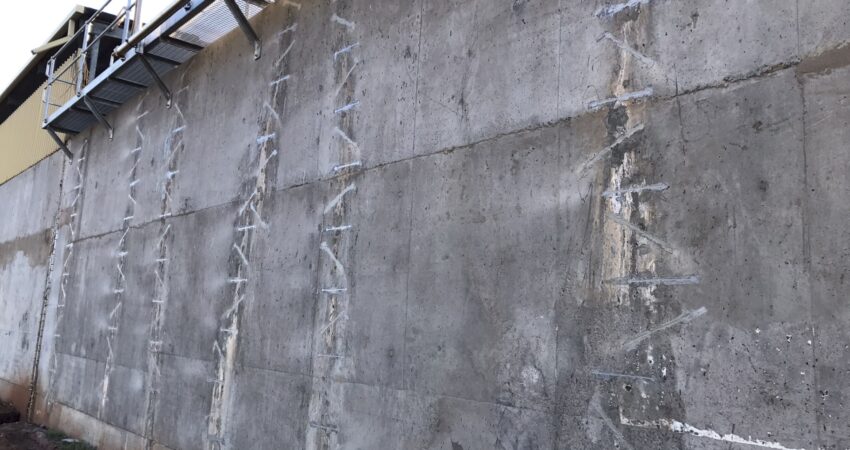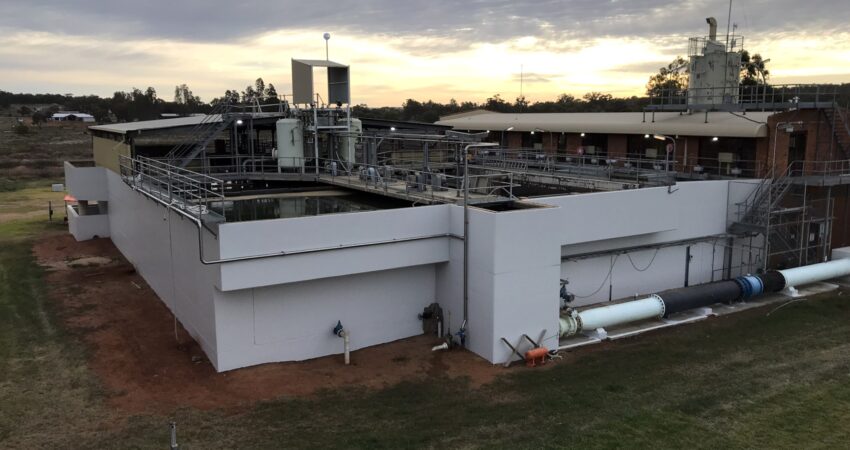Duratec recently remediated concrete structures at the GWTP, allowing the client to benefit from improved safety, compliance and value-for-money.
The Griffith Water Treatment Plant (GWTP), and its associated infrastructure, is located in the Riverina region of south-western New South Wales, about four hours’ drive from Canberra. Predominantly a rural area, the City of Griffith also includes several townships and villages.
The lay of the land – three critical assets
1. The water treatment plant (GWTP)
Owned and operated by the Griffith City Council, the GWTP was commissioned in 1989 and produces about 60 megalitres of drinking water per day for the local government area, which consists of nearly 30,000 people. While Council had undertaken some concrete remedial work over the years, the organisation was looking to further extend the life of the GWTP and its associated infrastructure, which includes the Raw Water Pump Station (RWPS).
1. a) The raw water pump station (RWPS)
Constructed in 1987, the RWPS extends eight metres below ground level and is located about 300 metres away from the GWTP, to which it supplies raw water.
2. The water reclamation plant (GWRP)
The GWRP is a sewage treatment plant, which was upgraded to use a more efficient, more environmentally friendly and higher quality membrane bioreactor (MBR) process in 2012. A section of the inlet works, which was constructed in the early 1990s, was retained and still in operation.
Pre-works – what’s the damage?
Water-containing structures at both the GWTP and GWRP had been showing signs of ageing, including corrosion and erosion. Some expansion and construction joints were leaking and showing signs of failure.
In late 2021, an investigation of all three structures, i.e. the GWTP (incorporating the RWPS) and the GWRP, was undertaken to identify the type and extent of the degradation. The report revealed the following:
1. The GWTP
Issue
The alkali-silica reaction was the main cause of deterioration at the GWTP and the Griffith City Council was told that the structure would fail if action were not taken. On top of this, soft water attack had caused cement-matrix loss.
Solution
- Cleaning and preparation of surface
- Restoration of concrete using epoxy resin and the new Ardex Rhino Crack Lock product
- Application of protective coatings to internal and external surfaces
1. a) RWPS
Issue
While the RWPS was generally in very good condition, minor leaks in the concrete were discovered.
Solution
- Crack injection to seal water leaks in walls
- Application of high-performance coating to seal all surfaces, including walls, floor and roof
2. The GWRP
Issue
While a large part of the GWRP’s inlet works had been coated in a protective membrane in the late 2000s and was still in excellent condition, there was a section that had been severely corroded due to hydrogen sulfide (H2S) attack.
Solution
- Removal of corroded concrete via hydrodemolition
- Finding of sound concrete, followed by building up reinforcing concrete to its original level
- Application of protective coating to prevent H2S attack and microbial-induced corrosion
Duratec gets to work
First port of call – the GWTP
After conducting its own condition assessment of the structures, Duratec mobilised on site in July 2022. The crew began works on the GWTP, pressure-washing the structure’s surfaces to ensure all defects were clearly visible and that the previously devised scope was accurate.
The team then got stuck into the concrete remediation works, sealing joints and making repairs via crack injection. All the while, they followed the specifications previously made by a third-party consultant.
Duratec also undertook ‘crack stitching’ using an innovative new Ardex Rhino Crack Lock product. Blade-width cuts were made across each crack and filled with epoxy paste. The crew then inserted the carbon-fibre Crack Lock rods to permanently bond both sides of the crack together. More epoxy was then inserted and the length of the crack was sealed.
Following this stage, the team re-pressure-washed the surfaces and primed the concrete with FOSROC Nitoprime. The next step involved sealing the remediated concrete and it was at this point that Duratec recommended a variation to the initial specifications.
While a clear coating had been specified, the team felt that FOSROC Dekguard E2000 in a colour that matched the structure, like-for-like, would provide both superior protection and a more aesthically pleasing finish. As well as preventing chlorides from attacking the steel reinforcement, the coating is resistant to carbonation, UV light and rain.
The client accepted Duratec’s recommendation, allowing the team to complete the repairs, while also ensuring a more uniform finish.
Next up – the GWRP
The crew then moved on to the GWRP, which displayed areas of severe concrete deterioration. After cleaning and preparing the structure’s surfaces, the team removed the damaged concrete through hydrodemolition, i.e. ultra-high-pressure water-blasting. This method was preferred over mechanical breakout as it is gentler on the environment, quieter than heavy-duty equipment, and ensures the structure and steelwork are not damaged.
Upon completion of the concrete removal process, the team discovered that the deterioration was more extensive than originally thought. As a result, Duratec downed tools to consult with the Council and decide on the best way forward.
While shotcrete had been specified for the repairs, the team considered gunite to be a superior option. Gunite generally lasts longer, dries faster and creates a smoother surface.
The client saw value in the variation so Duratec went ahead with the application of FOSROC Guncrete E, while also undertaking a form-and-pour technique using FOSROC’s Renderoc LA55. A minimum of 28 days is required for the gunite to cure so the team worked hard to complete the works prior to their Christmas 2022 deadline.
Back to work at the GWRP
The crew returned to site in January 2023 and started preparing the surfaces for coating. The process required sandblasting so Duratec encapsulated the area to prevent garnet from escaping into the GWRP’s surrounds, in turn, adhering to Duratec’s environmental guidelines.
Following sandblasting to remove the existing coating, the surfaces were cleaned and it became clear that coating works, outside of the original scope, were required. The client proceeded with the additional areas and the team got to work applying Polibrid 705E – an ultra-high-build, flexible coating designed to protect concrete and steel in chemical, abrasion and high-impact environments. In this instance, the coating was selected for its effectiveness in protecting the surfaces from hydrogen sulfide – a chemical naturally emitted by wastewater.
Final step – back to the GWTP
Once the Polibrid works were finished, the team moved back to the GWTP to seal the concrete in other areas, including the RWPS. They used Sikafloor-400 N – an anti-slip membrane as the floor can become quite slippery as a result of the coagulant used to make the water potable.
Challenges overcome
The team overcame a variety of challenges while working on this project through innovative thinking, client collaboration and the valuable input of Duratec’s in-house technical team.
Variations
While Duratec recommended numerous variations to the original specifications, the team made sure to clearly communicate the reasons behind such advice to the client. To its credit, the Council was consistently open to changes, including increases to the scope of works, as it had an excellent understanding of how the variations would allow for maximum life extension of the assets. The Council also had an appreciation of the improved safety, compliance and value-for-money such recommendations would bring.
Weather
In 2022, the east coast of Australia experienced its wettest winter in many years. While the rain caused some delays, Duratec worked hard to complete the works as quickly as possible, while also ensuring high-quality outcomes.
Ironically, almost as soon as it stopped raining, the region experienced 40-degree heat which posed a different challenge. In line with safety guidelines, Duratec crew members were required to wear heavy protective suits, as well as respirators, while undertaking coating works. To mitigate this, the team broke down the coating works into stages, minimising the time each worker spent in the heat.
A successful project outcome
Duratec was originally engaged by Griffith City Council as a result of its own forward thinking. The client’s internal specialists had had the foresight to plan for remediation works before the integrity of the concrete posed a serious risk. They were also well informed about the necessity for the regular monitoring and maintenance of their assets.
A strong collaborative approach allowed Duratec to build a solid, two-way working relationship with the Council, which optimised not only the efficiency of the process but also the quality of the outcome.
The successful delivery of this project has extended the life of GWTP and GWRP assets by about 20 years. Through ongoing monitoring and maintenance into the future, the Council will be able to stay on top of further concrete remediation requirements as they arise. Through this approach, the organisation stands to benefit from the aforementioned safety and compliance improvements, as well as increased value for money.




















